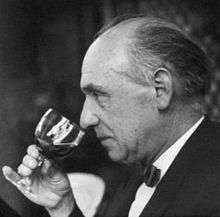Pierre Le Roy de Boiseaumarié
| Pierre Le Roy de Boiseaumarié | |
|---|---|
 | |
| Born |
5 April 1890 Mortagne-au-Perche, Orne, France |
| Died |
16 June 1967 (aged 77) Chateauneuf du Pape, Vaucluse, France |
| Nationality | French |
| Occupation | lawyer and viticulturist |
| Awards | Médaille militaire, Croix de Guerre, Légion d'honneur |
Pierre Le Roy de Boiseaumarié (1890-1967), nicknamed Baron Le Roy, was a World War I fighter pilot credited with five aerial victories.[1] He was the co-founder of the Institut National des Appellations d'Origine (INAO) and guided the creation of the Appellation d'origine contrôlée (AOC) system which is the basis of not only French wine laws but has also been influential in the laws and appellation systems across the globe.
Life
Pierre Le Roy was born in 1890 in Normandy. His father was a cavalry officer who was decommissioned from the army for protesting again the law separating the church and the state. The family left their property in Mortagne-au-Perche and moved to Vendargues in the Hérault where they managed an estate producing wine. Le Roy studied law. On 9 June 1907 during the revolt of the Languedoc winegrowers Le Roy set fire to the door of the courthouse of Montpellier to prevent the troops who had been confined inside from shooting at the demonstrators.[2]
During World War I Le Roy served as a fighter pilot. He was awarded the Médaille militaire, Croix de Guerre and the Légion d'honneur. In 1919 he married Edmée Bernard Le Saint, heiress of the Château Fortia, one of the most prestigious wine producing estates in the village of Châteauneuf-du-Pape in the Vaucluse department of southern France.[3] He became a prominent figure in not only the history of Châteauneuf-du-Pape but also in the history of French wine. In 1935 he and Joseph Capus co-founded the Institut National des Appellations d'Origine (INAO) and spearheaded the creation of the Appellation d'origine contrôlée (AOC) system that would become the basis of the French wine laws and continue to influence European wine laws into the twenty-first century.[3]
References
- ↑ http://www.theaerodrome.com/aces/france/leroy.php
- ↑ Pouget.
- 1 2 Portes 1993, pp. 297-298.
Sources
- Pouget, Richard, Evènements Viticoles de 1907 (in French), retrieved 2018-03-01
Sources
- Portes, Jean-Claude (1993). Châteauneuf-du-Pape. Mémoire d'un village (in French). Avignon: Alain Barthélemy. ISBN 978-287923031-3.
Further reading
- Charnay, Pierre (1990). Le premier vigneron du monde aurait cent ans (PDF) (in French). Saint-Gilles, Gard, France: Lyber's.